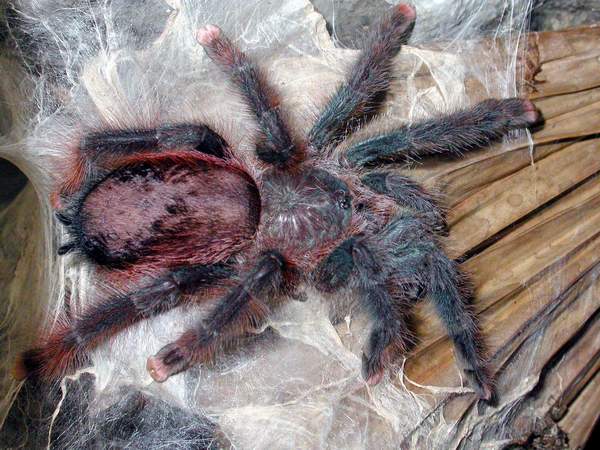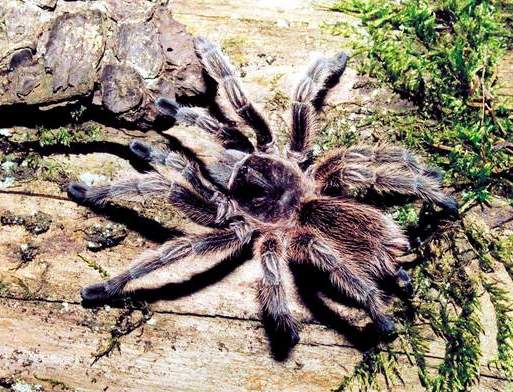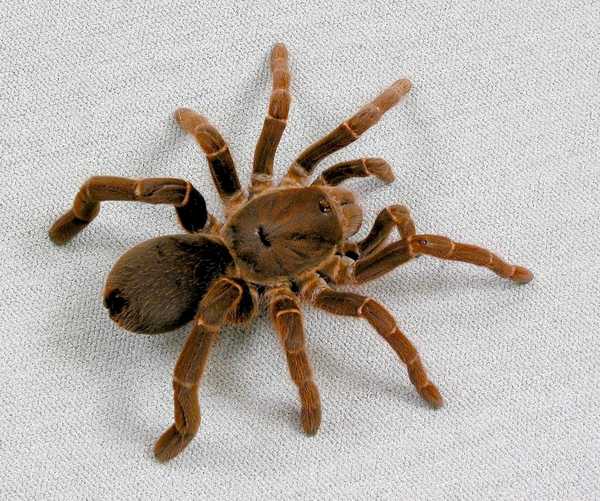Keeping tarantulas in captivity.
In spite of enourmous variety of conditions and places of tarantula habitats, greater amount of species and difference in their lifestyle, keeping of all tarantulas is defined with relatively small complex of conditions: humidity, temperature, food, presence of water for drinking. Presence of covertures is also an essential factor for many species, though, in the opinion of author, only small quantity of species of tarantulas finally unapt to get accustomed to live without retreats. However, its presence can be essential factor for their successful breeding.
Now lets examine in detail that factors and conditions is necessary to take into account in keeping tarantulas in captivity.
As a matter of convenience and simplifications of description, as well as use the available knowledges about tarantulas with reference to conditions of keeping in captivity conditionally lets devide all representatives of family Theraphosidae on two main basic groups – arboreal (group 1) and terrestrial tarantulas. In turn, terrestrial species is possible to divide into three categories: requiring moderate keeping condition (group 2-«moderate»), humid warm conditions (group 3 -«humid») and dwelling dry and scrub-lands (group 4 – «dry»).
 Group 1 presents itself tarantulas from small (part of Tapinauchenius) to very large sizes (Poecilotheria). Most of them quick and aggressive spiders and especially impetuous are long-legged species. Many are actively self-protected and part of them considering to has extremely unpleasant and harmful bite for human (Heteroscodra, Stromatopelma).
Group 1 presents itself tarantulas from small (part of Tapinauchenius) to very large sizes (Poecilotheria). Most of them quick and aggressive spiders and especially impetuous are long-legged species. Many are actively self-protected and part of them considering to has extremely unpleasant and harmful bite for human (Heteroscodra, Stromatopelma).
All arboreal species needs slighly moisten substratum, terrarium with good ventilation and equipping with a coverture in the manner of vertically stated piece of bark, wood stem or trunk, as well as obligatory presence of water bowl for drinking and keeping humidity. It is necessary also to spray a terrarium periodically. Not a single species has "urticating hairs" except representatives of genuses Avicularia, Pachistopelma, Iridopelma.
 Group 2 includes mostly slow terrestrial tarantulas. They usually not very aggressive and is enough calm, but, as a rule, shakes "urticating hairs" from abdomen being irritating. Tarantulas pertain to this group dwelling in regions with «winter season» and so, having clearly denominated cold period. These species must be kept on mildly moistened substratum, under average ventilation of terrarium and obligatory presence of water for drinks. Tarantulas being bred in captivity seems to be not required for organization of diapause (resting period). Representatives: most species of genus Aphonopelma, some Brachypelma, also Grammostola rosea and other species from territories of North America, Mexico and Chile.
Group 2 includes mostly slow terrestrial tarantulas. They usually not very aggressive and is enough calm, but, as a rule, shakes "urticating hairs" from abdomen being irritating. Tarantulas pertain to this group dwelling in regions with «winter season» and so, having clearly denominated cold period. These species must be kept on mildly moistened substratum, under average ventilation of terrarium and obligatory presence of water for drinks. Tarantulas being bred in captivity seems to be not required for organization of diapause (resting period). Representatives: most species of genus Aphonopelma, some Brachypelma, also Grammostola rosea and other species from territories of North America, Mexico and Chile.
 Group 3 is presented by large, enough nervious and aggressive tarantulas, inhabits humid equatorial or rain forests with long-lasting raining season. All species of this group needs for humid substratum, the majority of this tarantulas is required to place the retreat (coverture). It is recommended for keep a high level of humidity under average ventilation of terrarium. Mainly all species shakes "urticating hairs". Here pertain the largest representatives: Hysterocrates, Phoneyusa, Haplopelma, Cyriopagopus, Chilobrachys others, as well as west-african and majority of asiatic species of Tarantulas. On american continent this group is presented with genuses Theraphosa, Lasiodora, Xenesthis, Megaphobema, Pamphobeteus, Vitalius, Acanthoscurria, Nhandu, Sericopelma, Grammostola (majority of species), Ephebopus, Paraphysa and others from north part of South America.
Group 3 is presented by large, enough nervious and aggressive tarantulas, inhabits humid equatorial or rain forests with long-lasting raining season. All species of this group needs for humid substratum, the majority of this tarantulas is required to place the retreat (coverture). It is recommended for keep a high level of humidity under average ventilation of terrarium. Mainly all species shakes "urticating hairs". Here pertain the largest representatives: Hysterocrates, Phoneyusa, Haplopelma, Cyriopagopus, Chilobrachys others, as well as west-african and majority of asiatic species of Tarantulas. On american continent this group is presented with genuses Theraphosa, Lasiodora, Xenesthis, Megaphobema, Pamphobeteus, Vitalius, Acanthoscurria, Nhandu, Sericopelma, Grammostola (majority of species), Ephebopus, Paraphysa and others from north part of South America.
 Group 4 includes species inhabits arid biotopes with long-lasting dry season. This is nervious, probably the most aggressive tarantulas of world fauna. Majority of species actively spins web, many known by its adherence to digging deep burrows. Representatives: Citharischius, Pterinochilus, Ceratogyrus, Eucratoscelus and others from east and south part of Africa. From South America this froup includes species Chromatopelma cyaneopubescens from bushlands of Venezuela.
Group 4 includes species inhabits arid biotopes with long-lasting dry season. This is nervious, probably the most aggressive tarantulas of world fauna. Majority of species actively spins web, many known by its adherence to digging deep burrows. Representatives: Citharischius, Pterinochilus, Ceratogyrus, Eucratoscelus and others from east and south part of Africa. From South America this froup includes species Chromatopelma cyaneopubescens from bushlands of Venezuela.
Corresponding of Your pet tarantula to current group from four mentioned above will be the main defining factor of selecting the correct conditions of its keeping in captivity: humidity, temperature, presence of covertures and water for drinking.